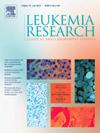非典型BCR::ABL1转录本慢性髓系白血病患者TKIs的临床特征和治疗反应
IF 2.1
4区 医学
Q3 HEMATOLOGY
引用次数: 0
摘要
一小部分(0.3 %-4.6 %)慢性髓性白血病(CML)患者表现出非典型转录本,临床意义不明确。为了探讨这些患者的临床特征和治疗反应,本研究回顾性分析了52例CML患者的8种非典型转录本。最常见的三种类型是e19a2、e1a2和e13a3/e14a3。与典型转录本患者相比,e19a2患者(n = 17)年龄更大,女性更常见,血小板水平升高。同样,e1a2患者(n = 6)以女性为主。在治疗反应方面,e19a2患者1年的累积完全细胞遗传学缓解率(CCyR)较低(41.2 % vs 85.3% %)和e1a2患者(16.7 % vs 87.5 %)。e19a2和e1a2患者无失败生存(FFS)的概率较低。此外,e19a2患者的无进展生存(PFS)概率较低。然而,非典型和典型队列之间的总生存率(OS)相当,可能归因于第二代tki的挽救治疗。e13a3/e14a3患者的临床特征、治疗反应和结局均无差异(n = 11)。值得注意的是,罕见的亚型表现出多种疾病表现,e8a2 (n = 3)与惰性病程相关,e6a2 (n = 2)与快速进展相关。一般来说,非典型转录亚型定义了具有不同TKI敏感性的临床异质性CML亚组。e19a2和e1a2转录本患者对伊马替尼表现出潜在的耐药性,但在第二代TKI治疗下,与典型转录本患者的结果相似。本文章由计算机程序翻译,如有差异,请以英文原文为准。
Clinical features and treatment response to TKIs in chronic myeloid leukemia patients with atypical BCR::ABL1 transcripts
A small percentage (0.3 %-4.6 %) of chronic myeloid leukemia (CML) patients exhibit atypical transcripts with poorly defined clinical implications. To explore the clinical features and treatment response in those patients, this study retrospectively analyzed 52 CML patients with eight types of atypical transcripts. The three most common types were e19a2, e1a2, and e13a3/e14a3. Compared to patients with typical transcripts, those with e19a2 (n = 17) were older, more frequently female, and had elevated platelet levels. Similarly, patients with e1a2 (n = 6) were predominantly female. Regarding treatment response, the lower cumulative rates of complete cytogenetic response (CCyR) by 1 year were seen in patients with e19a2 (41.2 % vs 85.3 %) and e1a2 (16.7 % vs 87.5 %). The probabilities of failure-free survival (FFS) were lower in patients with e19a2 and e1a2. Additionally, the probabilities of progression-free survival (PFS) were lower in patients with e19a2. However, overall survival (OS) was comparable between atypical and typical cohorts, likely attributable to salvage therapy with second-generation TKIs. No differences were found in clinical features, treatment response, and outcomes among patients with e13a3/e14a3 (n = 11). Notably, rare subtypes exhibited diverse disease manifestations, with e8a2 (n = 3) linked to indolent course and e6a2 (n = 2) associated with rapid progression. In general, atypical transcript subtypes define a clinically heterogeneous CML subgroup with differential TKI sensitivity. Patients with e19a2 and e1a2 transcripts exhibit potential resistance to imatinib but achieve similar outcomes to patients with typical transcripts under second-generation TKI therapy.
求助全文
通过发布文献求助,成功后即可免费获取论文全文。
去求助
来源期刊

Leukemia research
医学-血液学
CiteScore
4.00
自引率
3.70%
发文量
259
审稿时长
1 months
期刊介绍:
Leukemia Research an international journal which brings comprehensive and current information to all health care professionals involved in basic and applied clinical research in hematological malignancies. The editors encourage the submission of articles relevant to hematological malignancies. The Journal scope includes reporting studies of cellular and molecular biology, genetics, immunology, epidemiology, clinical evaluation, and therapy of these diseases.
 求助内容:
求助内容: 应助结果提醒方式:
应助结果提醒方式:


